Growth of Tissues of Higher Plants in Continuous Liquid Culture and Their Use in a Nutritional Experiment
Item
-
Title
-
Growth of Tissues of Higher Plants in Continuous Liquid Culture and Their Use in a Nutritional Experiment
-
Date
-
1965
-
Index Abstract
-
Not Available
-
Photo Quality
-
Complete
-
Report Number
-
AMRL TR 65-101
-
Creator
-
Tulecke, Walter
-
Corporate Author
-
Boyce Thompson Institute for Plant Research, Inc.
-
Laboratory
-
Aerospace Medical Research Laboratories
-
Extent
-
46
-
Identifier
-
AD0620047
-
Access Rights
-
CFSTI
-
Distribution Classification
-
1
-
Contract
-
AF 33(616)-1355
-
DoD Project
-
None Given
-
DoD Task
-
None Given
-
DTIC Record Exists
-
No
-
Distribution Change Authority Correspondence
-
None
-
Distribution Conflict
-
No
-
Abstract
-
The purpose of this work was twofold: (1) to devise a continuous culture system for higher plant cells and (2) to produce a sufficient amount of plant tissue culture for a nutritional experiment with weanling mice. The overall purpose of this work is to provide information for the evaluation of plants as food sources in long term space missions and as possible future sources of supplementary protein. Rose tissue was the most suitable for growth in liquid culture and approximately 40 pounds (20 kg) fresh weight of sterile tissue was produced from seven cultures which were harvested periodically over a period of 222 days. The cultures were of 8 liters volume and this amount was maintained by replacing the medium which was harvested. The average yield was 112 g/1 fresh weight (4.6 g/1 dry weight)/day. Approximately 10 pounds (5.0 kg) of contaminated rose tissue was also produced. When incorporated into a test diet for weanling mice, the sterile rose tissue was a better food supplement than contaminated rose. A bacterial contaminant which grew well with the rose tissue and did not appreciably alter the growth rate was isolated and identified as Achromobacter liquefaciens. Since this was a reisolated type species for the genus, it was deposited in the American Type Culture Collection (ATCC No. 15716). Protein determinations on the rose tissue showed a high protein level for tissue grown in continuous culture as compared to tissue grown in flasks.
-
Report Availability
-
Full text available
-
Date Issued
-
1965-07
-
Provenance
-
RAF Centre of Aviation Medicine
-
Type
-
report
-
Format
-
1 online resource
 AMRLTR65-101.pdf
AMRLTR65-101.pdf